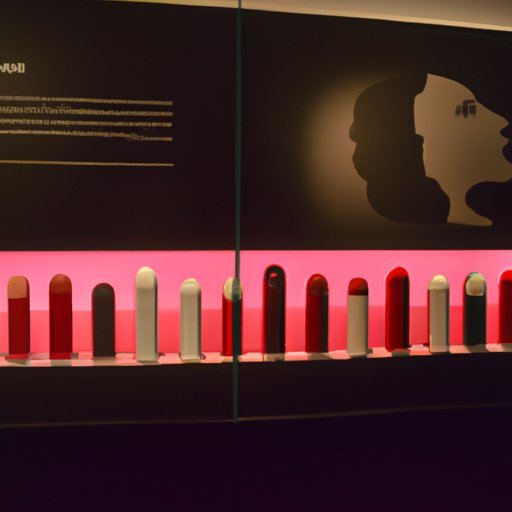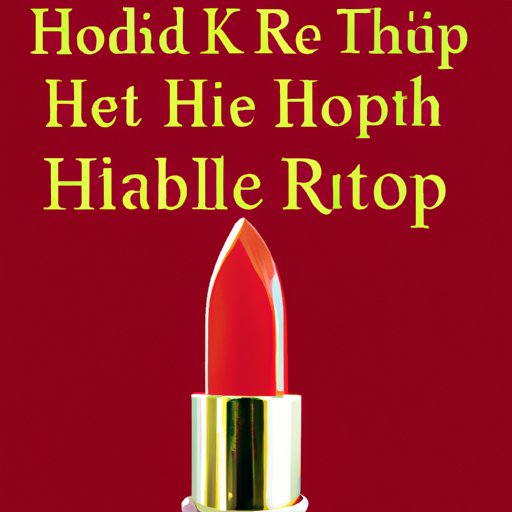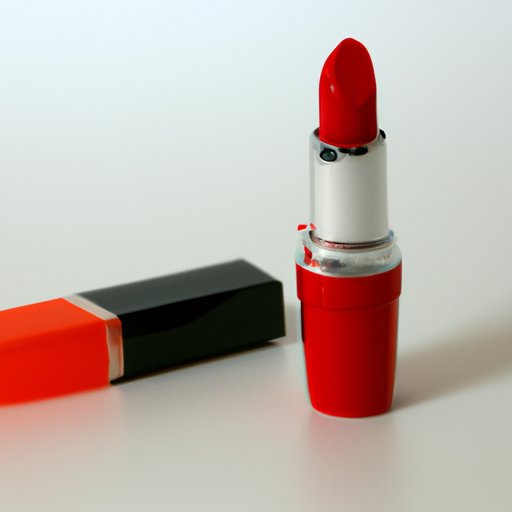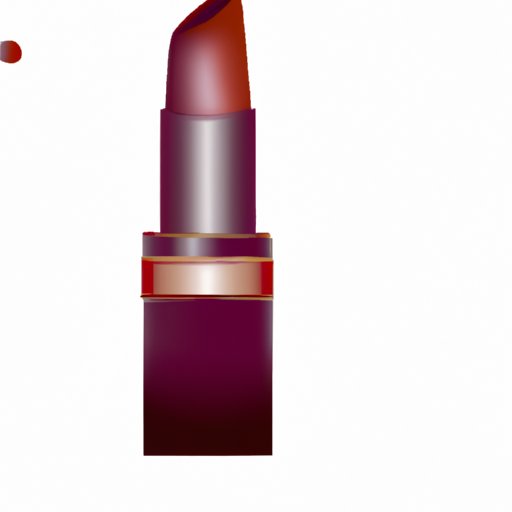Introduction
Lipstick has become a global phenomenon, with millions of people around the world wearing it every day. But when was lipstick invented? To answer this question, we must look back at the history of lipstick and trace its invention and development through time. This article will explore when lipstick was invented, as well as the societal, economic, and cultural factors that have shaped its use and popularity.

A Historical Overview of Lipstick: Tracing the Invention and Development of Lipstick Through Time
The exact origin of lipstick is unknown, but historians believe it dates back thousands of years. Here is a brief overview of the key milestones in the history of lipstick.
Ancient Egypt: The First Recorded Use of Lipstick
The first recorded use of lipstick can be traced back to ancient Egypt, where Cleopatra and other members of the royal family used a combination of red ochre, crushed insects, and beeswax to create a reddish-brown pigment that they applied to their lips. This was seen as a sign of wealth and status, and it quickly spread among the wealthy elite.
The Middle Ages: Growing Popularity of Lipstick
During the Middle Ages, lipstick became more widely available and was used by both men and women. It was often made from a mixture of beeswax, butter, and various plant dyes. However, during this period, lipstick was still seen as a sign of vanity and many religious figures spoke out against it. As a result, it was largely frowned upon by society.
The Renaissance: Lipstick Becomes a Status Symbol
By the Renaissance period, lipstick had become a symbol of power and status. Royalty and nobility would wear bright colors such as reds and pinks to signify their wealth and importance. During this period, lipstick was also used as a way to enhance one’s appearance and attract potential suitors.
The Beauty Revolution: Exploring the History and Evolution of Lipstick
As the centuries passed, lipstick continued to evolve. Here is a look at some of the key milestones in the history of lipstick.
19th Century: Lipstick Becomes a Sign of Femininity
In the 19th century, lipstick began to be seen as a sign of femininity. Women started to use it to enhance their features and draw attention to their lips. During this period, lipstick was made from a variety of ingredients including beetroot juice, carmine, and even toxic substances such as lead and mercury.
20th Century: Lipstick Gains Popularity in the West
In the early 20th century, lipstick gained widespread popularity in the Western world. During this period, brands such as Elizabeth Arden and Maybelline began to produce lipsticks in a variety of shades. Lipstick also became a symbol of female empowerment, with suffragettes using it to make bold statements about their rights.
21st Century: Lipstick as a Global Fashion Statement
Today, lipstick is a global fashion statement. According to a 2017 survey conducted by the market research firm Mintel, 74% of women in the United States alone wear lipstick. It has become an essential part of any makeup look, and there is a wide range of products available to suit every individual style.

Red Hot: A Comprehensive Guide to the History of Lipstick
When it comes to lipstick, there is a lot to learn. Here is a comprehensive guide to the history of lipstick.
Types of Lipstick: From Matte to Glossy
Throughout the years, lipstick has come in many different forms. Today, there are several types of lipstick available, from matte to glossy. Matte lipstick has a flat finish and is long-lasting, while glossy lipstick has a shiny finish and provides more hydration.
Lipstick Ingredients: Natural vs Synthetic
Lipstick is made up of a variety of ingredients, both natural and synthetic. Natural ingredients include plant-based oils, waxes, and pigments, while synthetic ingredients include preservatives, emollients, and fragrances. Both types of ingredients can be beneficial for the lips and provide different benefits.
Lipstick Colours: Classic Reds, Pinks, and Beyond
Lipstick comes in a wide range of colours, from classic reds and pinks to more daring shades such as blues, purples, and greens. Lipstick can also be used to create a variety of looks, from subtle to dramatic.
The Rise of Red Lips: How Lipstick Became a Global Phenomenon
So how did lipstick become so popular? Here is a look at some of the key factors that have contributed to its rise.
Lipstick Advertising: How Brands Have Marketed Lipstick
Over the years, brands have used a variety of methods to market lipstick. From print ads to television commercials, brands have used creative campaigns to showcase their products and encourage people to try them. Additionally, many brands have collaborated with celebrities to promote their lipsticks, further increasing awareness of the product.
Social Media Influence: How Lipstick Has Evolved With Technology
Social media has played an important role in the evolution of lipstick. Platforms such as Instagram and YouTube have allowed influencers to share their favourite products and create trends. This has increased the reach of lipstick and allowed more people to discover it.
Celebrity Endorsements: How Stars Have Shaped Lipstick Trends
Celebrities have also had a major impact on the popularity of lipstick. From Marilyn Monroe to Rihanna, stars have used their fame to promote their favourite lipsticks and create trends. This has encouraged people to experiment with different shades and styles of lipstick.
From Ancient Egypt to Today: Examining the Origins and Popularity of Lipstick
While lipstick has been around for centuries, its use and popularity have changed over time. Here is a look at some of the societal, economic, and cultural factors that have influenced the use of lipstick.
Societal Expectations: How Society’s Ideas of Beauty Have Changed Over Time
Society’s ideas of beauty have changed over time, and this has had an impact on the use of lipstick. For example, during the Middle Ages, lipstick was seen as a sign of vanity and frowned upon by society. However, in the 19th century, it began to be seen as a sign of femininity and a way to enhance one’s features.
Economic Factors: How Accessibility and Affordability Have Influenced Lipstick Use
The accessibility and affordability of lipstick have also had an impact on its use. In the past, lipstick was expensive and only available to the wealthy. However, with the advent of mass production, lipstick became more affordable and accessible to everyone.
Cultural Impact: How Lipstick Has Become an International Trend
Finally, the cultural impact of lipstick has been significant. Lipstick has become a global trend, with people in countries around the world wearing it. It has become a way to express oneself and make a statement, no matter where you are.

Paint It Red: A Look at the Invention and Popularity of Lipstick
This article has explored when lipstick was invented and the factors that have influenced its use and popularity. Here is a look at some additional topics related to lipstick.
Lipstick Myths: Debunking Common Misconceptions
There are many myths surrounding lipstick, from the belief that it causes cancer to the idea that it is bad for your lips. However, experts agree that these myths are not true and that lipstick can be safely used. In fact, some lipsticks contain moisturizing ingredients that can help protect and nourish the lips.
Health Risks: Understanding the Potential Dangers of Lipstick
Although lipstick is generally safe to use, it can pose certain health risks. Some lipsticks contain potentially harmful ingredients such as lead and parabens, which can be absorbed into the body. It is important to check the ingredients list of any lipstick before purchasing it.
Lipstick Alternatives: Exploring Non-Toxic Options
If you are looking for a non-toxic alternative to traditional lipstick, there are several options available. Natural lipsticks are made with plant-based ingredients and are free from harmful chemicals. Additionally, tinted lip balms and lip stains are great alternatives for those who want a sheer, natural look.
Conclusion
Lipstick has been used for centuries and its popularity continues to grow today. This article has explored the invention and development of lipstick, as well as the societal, economic, and cultural factors that have shaped its use and popularity. From Ancient Egypt to the 21st century, lipstick has come a long way and its use shows no signs of slowing down.
The benefits of wearing lipstick are clear: it can help enhance one’s features and make a statement. Whether you prefer classic reds or bold pinks, there is a shade and style of lipstick to suit everyone. So go ahead and paint it red!
(Note: Is this article not meeting your expectations? Do you have knowledge or insights to share? Unlock new opportunities and expand your reach by joining our authors team. Click Registration to join us and share your expertise with our readers.)
